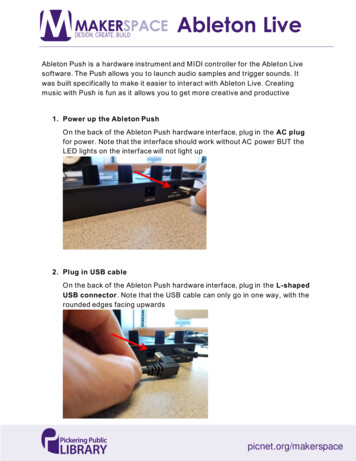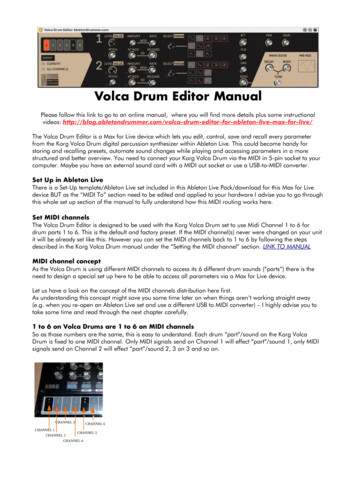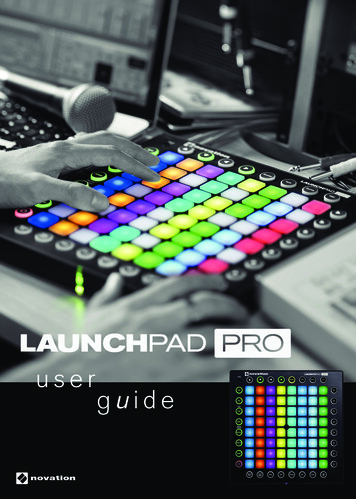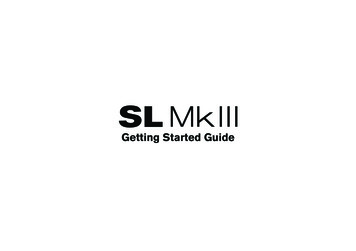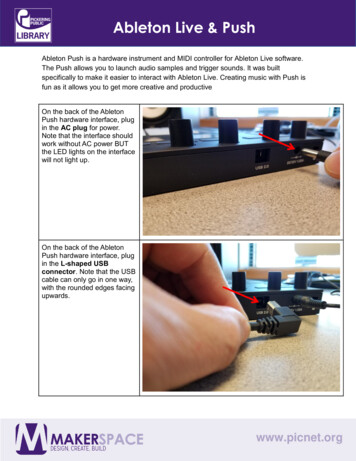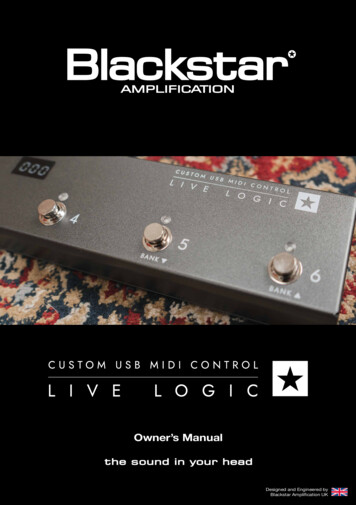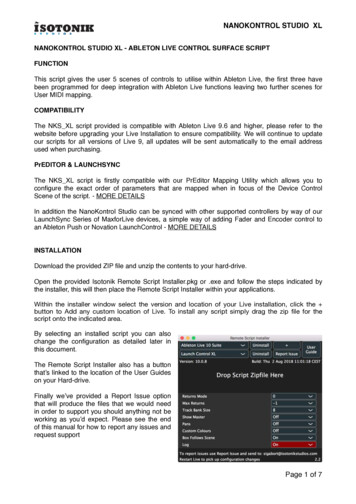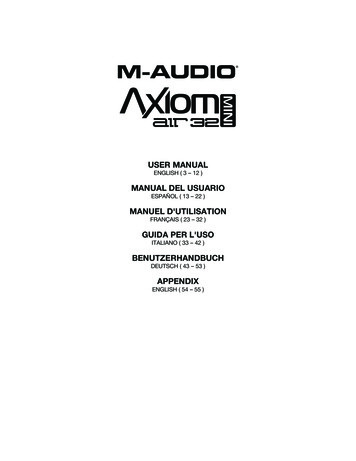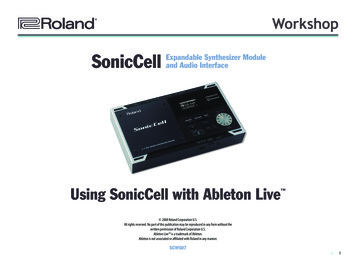
Transcription
Workshop ÂØÒňΠSonicCellExpandable Synthesizer Moduleand Audio InterfaceUsing SonicCell with Ableton Live 2008 Roland Corporation U.S.All rights reserved. No part of this publication may be reproduced in any form without thewritten permission of Roland Corporation U.S.Ableton Live is a trademark of Ableton.Ableton is not associated or affiliated with Roland in any manner.SCWS071
About the Workshop BookletsRoland’s SonicCell is designed for modern musicians. Using USB, It adds ahuge set of sounds to your digital audio workstation (or “DAW”) withoutadding to your computer’s workload. It’s also an audio interface that can getsignals from mics, instruments, or other devices to DAW tracks for recording.SonicCell’s Editor software allows you to program SonicCell from within yourDAW. Onstage, its compact size also makes SonicCell the ideal companionfor a laptop DAW, letting you perform and sing along with recorded tracks.Or use it to play back sequences and audio files from a USB memory stick.Understanding the Symbols in This BookletThroughout this booklet, you’ll come across information that deservesspecial attention—that’s the reason it’s labeled with one of the followingsymbols.A note is something that adds information about the topic at hand.A tip offers suggestions for using the feature being discussed.Each SonicCell Workshop booklet focuses on one SonicCell topic, and isintended as a companion to the SonicCell Owner’s Manual. This bookletrequires SonicCell O.S. Version 1.11 or higher. You can download the latestSonicCell O.S. for free from www.RolandUS.com.About This BookletThis booklet explains using SonicCell with Ableton Live. First we’ll discusssequencing MIDI tracks in Live using SonicCell’s synth sounds. Then we’ll talkabout using SonicCell as as an audio interface for recording live audio andSonicCell sounds as audio tracks in Live.We’ll assume you’ve installed and know how to operate Live—otherwise,consult Live’s built-in documentation in its Help menu. We’ll also assumeyou’ve read the Using SonicCell with a DAW and Using SonicCell as an AudioInterface Workshop booklets, that SonicCell and your computer are hookedup and turned on, and that you’re listening through SonicCell.Warnings contain important information that can help you avoidpossible damage to your equipment, your data, or yourself.Configuring Live to Work with SonicCellSetting Up Live for SonicCell Audio1From the Live menu, select Preferences. and click Audio along theleft edge of the Preferences window to open the Audio tab.2From the Audio Input Device popup menu, select Roland SonicCell[SonicCell’s current sample rate] (2 In, 2 Out).2
3From the Audio Output Device popup, select Roland SonicCell[SonicCell’s current sample rate] (2 In, 2 Out).Live’s sample rate is set by SonicCell. To use another sample rate,close Live’s Preferences window, set SonicCell as desired—see theUsing SonicCell with a DAW Workshop booklet for details—and thenrepeat Steps 1-3 above.Live has an easy-to-use system for setting the optimal buffer size, akey element in smooth audio-recording operations. To learn about it,see the “Audio I-O” section of Live’s built-in Lessons tab.2Set the Input Config window as desired and click OK.3There’s usually no need to manually set theoutput configuration, but you may want to checkit by clicking Output Config.4If it’s not already set as shown above, click whichever box is dark grayto turn both boxes on.5Click OK when you’re done—but don’t close the Preferences windowyet. We’ve got to set up MIDI communication between SonicCell andLive.Turning on the Desired SonicCell Inputs and Outputs1In the Audio tab, click the Input Config button.In this window, you turn on or off the desired SonicCell inputs byclicking them. They’re shown as single mono inputs on the left, andstereo pairs on the right.As Live’s onscreen text says, the fewer inputs you turn on, the less thestrain on your computer, so it makes sense to set this screen up theway you’re likely to want to work. (You can always change it later, ofcourse.) The screenshot below shows a sensible starting selection: Allof SonicCell’s mono input channels are turned on in mono, and all ofthe stereo inputs are turned on in stereo.3
Setting Up Live for SonicCell MIDI1In the Preferences window, click the MIDI Sync tab.2In the MIDI Ports area, activate incoming MIDI—by clicking the input: SonicCell Track button soit lights and reads “On.” outgoing MIDI—by clicking the Output: SonicCell Track buttonso it lights and reads “On.”After the SonicCell Editor exchanges data with SonicCell, the Editoropens, and a new track is created in the Session View.3Close the Preferences window.5To close the Editor, click its close button in the top-left corner of thewindow.6To re-open the Editor, click the newly createdSonicCell channel to display the SonicCellEditor device’s controls in the Track View. (If youdon’t see the device, toggle the Track/Clip Viewdisplay until you do.)7Click the control’s Plug-In Edit button to openthe Editor.Creating a SonicCell Editor Track1In the Session window, open the Live set you want to work on, orcreate a new one.2Click the Plug-In Device Browser to display your installedplug-ins.3Open the Roland folder to reveal the SonicCell Editor AUplug-in.4Drag the SonicCell Editor AU plug-in to the blank area tothe right of any Session View channels you already have,as shown in the following illustration.We recommend naming your SonicCell Editor channel so it’s easy tograb later on as you work.4
Using the SonicCell EditorPart-selection areaTo select a patch by:Patch-selection area memory location—click the PATCH NAME parameter’s popuparrow to reveal SonicCell’s patches organized by their memorylocations. category—click the CATEGORY parameter’s popup arrow toreveal SonicCell’s patches divided into categories.Mode-selection buttonsYou can select performances stored in SonicCell using the PERFORMNAME popup located above the part-selection area.Digging DeeperThe SonicCell Editor lets you change the current performance’s sounds in arange of ways. The mode-selection buttons to the left of the Editor windowdetermine the parameters you see and can edit at any given time. They’redivided into the following sections:You’ll find detailed instructions for using the SonicCell Editor in its manual,which you can display by clicking the Help button in the SonicCell Editorwindow. What follows here are some quick instructions to get you started.Everything you set up in the SonicCell Editor is automatically savedin your Live project. When you reload the project, the Editorautomatically sets up the current performance in SonicCell to match.Selecting a Patch for a PartYou choose each patch you want to use in Live by selecting it for the partthat a Live MIDI track is configured to play. Here’s how:1Click the part’s number in the PARTS area of the Editor window.2Select a patch for the part using the controls in the patch-selectionarea, circled in red above. SYSTEM—The buttons in this area allow you to set SonicCell’s globalbehavior, and also get quick access to its input effect, a handy thingwhen you’re recording live audio through SonicCell. PERFORM EFFECTS—These buttons edit the performance’s effect setup. PERFORM—These parameters allow you to control the way each partplays its patch, and lets you add effects to the patch. PERFORM PATCH—These parameters allow you to dig right inside apart’s patch in order to edit it down to its most basic characteristics.Before using the PERFORM PATCH buttons, be sure to select the partthat plays the patch you want to edit. You do this by clicking the part’snumber in the part-selection area at the top of the window.5
Sequencing with SonicCell PatchesIf you haven’t yet selected a patch on SonicCell to play from this track,use the SonicCell Editor’s track to assign the desired patch to thepart you want to use. Once you’ve done that, return to the MIDI trackyou’ve been setting up.In this section, we’ll assume you’re using SonicCell in Performance mode—using SonicCell’s PRST 01Seq: Template performance to start with. you’ve connected a MIDI controller to SonicCell’s MIDI IN jack—and turnedon SonicCell’s USB-MIDI THRU System parameter.1In the Session window, open the Live set you want to work on, orcreate a new one.2Click the Live Device Browser button to display Live’sdevice list.3Drag the External Instrument device into the blank area tothe right of ant Session View tracks you already have.6When you play your controller now, you should hear the desiredpatch play in SonicCell.7Record your SonicCell track as you would any other Live track—whenyou play it back, you’ll hear its SonicCell patch play.8Repeat Steps 3-7 for other SonicCell tracks you want to sequence.At this point, your track is sequenced, and you’ll hear it each time youplay your project, including when you edit the track. However, thesound is still coming from SonicCell itself—it hasn’t yet been recordedas an audio track in Live. We’ll get to that in the next section.Recording Audio from SonicCell in LiveIf you haven’t yet read the Using SonicCell as an Audio InterfaceWorkshop booklet, read it now before proceeding. SonicCell offers lotsof audio-interface options you’ll want to know about.Selecting Audio to Record45Live creates and selects a new Session Viewtrack for SonicCell, and a SonicCell deviceappears in the Track View below—this iswhere you’ll set up your MIDI track.In the SonicCell device, set the MIDI Toparameter to SonicCell, and select the MIDIchannel for the SonicCell part whose patchyou want to sequence. Leave the rest of thesettings at their default values.1Open the Live set you want to work on, or create a new one.2In the Arrangement view, display the input-selection popup menu byclicking and holding on the input area of the desired track.Here we’ve set up tosequence with Part 1.6
3Select the desired mono or stereo SonicCell input jack or jacks. (InLive, any track can be either mono or stereo—just select the type ofinput you want to use.) To record a mic or instrument connected to SonicCell’s Neutrik input jack—select 1. a stereo device connected to SonicCell’s Neutrik and (LINE) R inputjacks—select 1/2. a SonicCell synth patch in stereo—select 1/2. When you want to record a single synth track as a Live audio trackTurn Off Software MonitoringSet the track’s Monitor section to Off so you’relistening to the audio you’re recording directlythrough SonicCell.As we noted in the Using SonicCell with a DAW Workshop booklet, you dohave the option of listening through Live if you want to hear its effectsas you record—set the Monitor section to Auto or In, as explained inthe Live User Manual. However, since you may encounter latency doingthis, we recommend listening directly through SonicCell.mute any other SonicCell synth tracks you have in the song bytemporarily deactivating them in Live, or mute their parts in theSonicCell Editor. If you’ve connected a mic, instrument, or other device to one ofSonicCell’s inputs, disconnect it until you’re ready to record itsaudio onto a Live track.When you want to record live audio as a Live audio track, you can use eitherof two methods:There’s no need to configure the track’s output unless you have specialneeds. Each track’s output is automatically set to Master, which sendsits audio to SonicCell.1 If you need to hear your SonicCell synth tracks as you record—sendyour live audio through SonicCell’s input effect, and then set theTO COM parameter on the In/Out Routing screen to Input FX. If you don’t need to hear SonicCell synth tracks as you record—mute them in Live by clicking their Mute buttons to light them,or mute their parts in the SonicCell Editor.TroubleshootingIf you experience problems recording or playing back audio, Live’s built-inowner’s manual can provide insights that can help you solve your problem.See Chapter 25, “Computer Resources and Strategies.” In addition, raising theAudio Buffer size in SonicCell’s control panel may also help, though it mayalso increase latency if you’re working with soft synths in Live.The EndBefore Recording: SonicCell Audio-Recording StrategySince SonicCell can simultaneously be the source of synth sounds and yourlive audio, a little thought needs to be given to making sure you’re onlyrecording exactly what you intend to record on any given track.We hope you’ve found this workshop helpful. Keep an eye out for otherSonicCell Workshop booklets available for downloading at www.RolandUS.com.When you want, for example, to record a single SonicCell synth sound on itsown track, you don’t want another synth sound or live audio to find its wayonto the track. Likewise, if you’re recording a vocal or other live audio, youdon’t want your synths recorded on that same track. Here’s what to do.7
sequencing MIDI tracks in Live using SonicCell's synth sounds. Then we'll talk about using SonicCell as as an audio interface for recording live audio and SonicCell sounds as audio tracks in Live. We'll assume you've installed and know how to operate Live—otherwise, consult Live's built-in documentation in its Help menu.
